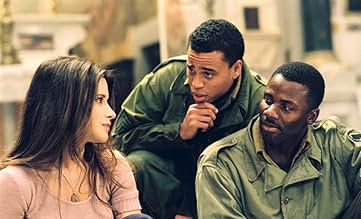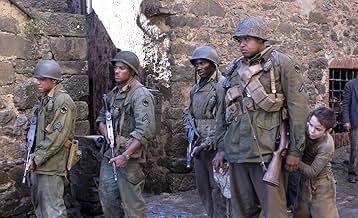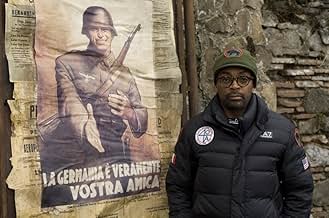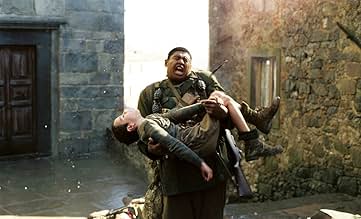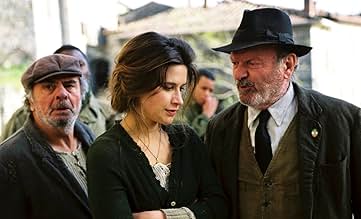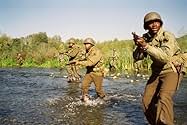ÉVALUATION IMDb
6,1/10
19 k
MA NOTE
Italie, 1944. L'histoire de quatre soldats américains noirs piégés dans un village de Toscane pendant la Seconde Guerre mondiale.Italie, 1944. L'histoire de quatre soldats américains noirs piégés dans un village de Toscane pendant la Seconde Guerre mondiale.Italie, 1944. L'histoire de quatre soldats américains noirs piégés dans un village de Toscane pendant la Seconde Guerre mondiale.
- Prix
- 1 victoire et 10 nominations au total
Lidia Biondi
- Natalina
- (as Lydia Biondi)
Avis en vedette
MIRACLE AT ST. ANNA got panned pretty severely. And I can see why. Lacking cohesion and hopscotching around like a child with A-D-D, the story is tough to follow. And what about the title? Exactly what is "the Miracle"? Some might say it's that this film ever got made. But there are some upsides to it that I think make this a semi-watchable flick.
The first plus is that it focuses on a little known regiment of black WW II fighters called "The Buffalo Soldiers." Spike Lee had apparently been aching to do another "black story" and found his muse in Nazi occupied Italy.
Although there's been some bashing related to overacting on the main characters' parts, I didn't find that to be the case. Derek Luke, Michael Ealy, and the rest of these band of brothers did fine in my eyes. Although Spike did have them doing things that weren't being done during this time (specifically the "high five" which wasn't realized until the late 70s), I did find their delivery of the story to be engaging enough, and kept me watching during its entire, lengthy, 2 hours and 40 minute run time.
I also really liked the on-site filming locations in Italy, which gave the entire production a very real quality. The cobbled streets, twisted landscape, and ancient-looking buildings were all well-shown in the film and had me ogling at various times.
But, as they say, all good things must come to an end. Although Spike Lee tries admirably to keep the story together, he too often wanders off on tangents that have nothing to do with the story. One particularly infuriating scene involves John Leguizamo (THE HAPPENING). He's in modern day Italy with his lover and his only use for being in the film is that he throws a newspaper out a window so that it lands on a man's table. Why couldn't the man have simply seen it at a newsstand? Why the whole set up with Leguizamo and the hot chick? Sex for the sake of sex, perhaps? The other, less infuriating, item that shows Spike wandering away was when he films the Buffalo boys being refused food service at a place back in the States before they were shipped overseas. Why this played a role in the film and what it had to do with the Miracle is anyone's guess.
Finally, there's the tough sell of the Miracle itself. Although people can debate what qualifies as a miracle, I think most would say it equates to something supernatural that cannot be explained by normal evidence. And here lies perhaps the biggest problem for Miracle at St. Anna. There really isn't a miracle. Perhaps it's well enough that one of the Buffalo men made it home and found his way to peace. Perhaps it's that the world spun and allowed the last surviving Buffalo Soldier to avenge the people of St. Anna and his fallen brothers. Perhaps ...but not likely.
The first plus is that it focuses on a little known regiment of black WW II fighters called "The Buffalo Soldiers." Spike Lee had apparently been aching to do another "black story" and found his muse in Nazi occupied Italy.
Although there's been some bashing related to overacting on the main characters' parts, I didn't find that to be the case. Derek Luke, Michael Ealy, and the rest of these band of brothers did fine in my eyes. Although Spike did have them doing things that weren't being done during this time (specifically the "high five" which wasn't realized until the late 70s), I did find their delivery of the story to be engaging enough, and kept me watching during its entire, lengthy, 2 hours and 40 minute run time.
I also really liked the on-site filming locations in Italy, which gave the entire production a very real quality. The cobbled streets, twisted landscape, and ancient-looking buildings were all well-shown in the film and had me ogling at various times.
But, as they say, all good things must come to an end. Although Spike Lee tries admirably to keep the story together, he too often wanders off on tangents that have nothing to do with the story. One particularly infuriating scene involves John Leguizamo (THE HAPPENING). He's in modern day Italy with his lover and his only use for being in the film is that he throws a newspaper out a window so that it lands on a man's table. Why couldn't the man have simply seen it at a newsstand? Why the whole set up with Leguizamo and the hot chick? Sex for the sake of sex, perhaps? The other, less infuriating, item that shows Spike wandering away was when he films the Buffalo boys being refused food service at a place back in the States before they were shipped overseas. Why this played a role in the film and what it had to do with the Miracle is anyone's guess.
Finally, there's the tough sell of the Miracle itself. Although people can debate what qualifies as a miracle, I think most would say it equates to something supernatural that cannot be explained by normal evidence. And here lies perhaps the biggest problem for Miracle at St. Anna. There really isn't a miracle. Perhaps it's well enough that one of the Buffalo men made it home and found his way to peace. Perhaps it's that the world spun and allowed the last surviving Buffalo Soldier to avenge the people of St. Anna and his fallen brothers. Perhaps ...but not likely.
Lee makes a European film allowing philosophical questions and moral questions to supplant desire for personal satisfaction and identifiable this is a Spike Lee film signature patterns. There are a number of excellent directorial decisions in this film. Lee's camera is sensitive, gentle and sincere. He shows us the many ways our eyes are deceived and how much of what we perceive is illusion. I think its a great film that is inspirational, has meaning and is both emotionally and intellectually satisfying. I hope that Lee will continue to make films outside his comfort zone and articulate events from the African American experience around the world to show our contribution to history and civilization.
Length is a factor for this film, and it's not the normal action driven war film. I was lucky enough to attend the premier in NY and from the perspective of a Cadet at West Point, I would say that I respected this film BECAUSE it "jumped around." It showed all perspectives and that there were people with good intentions on all sides. The bad intentions were included as well, and though it doesn't grab you the entire time, it tells an interesting tale. Sadly, most people don't go to see a war film for this reasons, they all want Saving Private Ryan these days. But that's not what war is always about, and this film shows the other aspects. The black soldiers are each equally representative of varying perspectives that these men had. With a lot of duality also represented, this film leaves a lot to think about if you watch it with the right eye. It seems most people I've talked to have a problem with length and action, but if you don't pay so much attention to that and just enjoy it, you'll find a nice film that takes a different approach.
Sometimes a true-blue filmmaker, full of art-filled aspirations and good intentions, isn't always the best judge of what will ultimately really work for the story. This has happened to Spike Lee on more than one occasion- this taking aside the fact that he has consistently puffed-up many of his films lenght-wise- and in Miracle at St. Anna he makes an admirable, powerful stumble. It's not embarrassing like Bamboozled or just laughable like She Hate Me; he has a goal here, and it's worth trying out. The message is made right in the first scene: John Wayne war movies are propagandistic drek that show really only one side. Spike Lee's 'version' of black soldiers embedded in a Tuscan village in WW2 is meant to be an antidote to all of those pompous, (practically) white-only war pictures. The problem is that he hasn't done much to advance the genre, or break out of anything really interesting with the bulk of the characters.
Ironic then that Lee should criticize Clint Eastwood's Flags of Our Fathers since both films suffer from similar faults: they're too long, too convoluted, occasionally far too schmaltzy, and whether by partnership (being co-produced by Spielberg himself) or just ripping-off, Saving Private Ryan is evoked more than once in the battle scenes. In the case of Lee's film, he also isn't entirely sure always how he wants to ground the picture: is it about the black soldiers on their quagmire of sorts, or about the little boy who nicknames the big friendly black soldier "Chocolate Giant", or about Partisans and their daring-do and corruption alongside the Nazi's? Or is it about believing in frigging miracles? Lee wants it to be about all of these things, and has made the running time of 160+ minutes so that he can fit as much as possible with pretty much anything and everything from James McBride's book packed in (this even includes anachronisms, like a German officer referring to the Geneva conventions!)
And while it is easy to criticize Lee for putting in so much, and overcrowding the mid-section of his picture (and eventually coming to some real head-scratching, groan-inducing bits towards the very end), there is passionate film-making on display. There are chunks that are compelling, that do convey the blatant racism that was pervasive at the time for anyone with dark skin color (albeit Lee stuffs in next to no white people who aren't dumb bigots), and the as-a-given brutality of the Nazi war machine. There's one particular scene, I should note where an entire town is massacred, that delivers the devastating effect Lee wants, and there are a couple others like it that deliver the visceral reaction intended with modern war pictures.
For all of its faults, for all of its hackneyed acting- including one guy who seems like a WW2 version of the Alpa Chino character from Tropic Thunder complete with gold tooth- and bits involving a precocious kid communicating by tapping, and for its mind-boggling plot twists, it is often well-directed and conscious of its message. It's a disappointment, to be certain, but there's worse. 5.5/10
Ironic then that Lee should criticize Clint Eastwood's Flags of Our Fathers since both films suffer from similar faults: they're too long, too convoluted, occasionally far too schmaltzy, and whether by partnership (being co-produced by Spielberg himself) or just ripping-off, Saving Private Ryan is evoked more than once in the battle scenes. In the case of Lee's film, he also isn't entirely sure always how he wants to ground the picture: is it about the black soldiers on their quagmire of sorts, or about the little boy who nicknames the big friendly black soldier "Chocolate Giant", or about Partisans and their daring-do and corruption alongside the Nazi's? Or is it about believing in frigging miracles? Lee wants it to be about all of these things, and has made the running time of 160+ minutes so that he can fit as much as possible with pretty much anything and everything from James McBride's book packed in (this even includes anachronisms, like a German officer referring to the Geneva conventions!)
And while it is easy to criticize Lee for putting in so much, and overcrowding the mid-section of his picture (and eventually coming to some real head-scratching, groan-inducing bits towards the very end), there is passionate film-making on display. There are chunks that are compelling, that do convey the blatant racism that was pervasive at the time for anyone with dark skin color (albeit Lee stuffs in next to no white people who aren't dumb bigots), and the as-a-given brutality of the Nazi war machine. There's one particular scene, I should note where an entire town is massacred, that delivers the devastating effect Lee wants, and there are a couple others like it that deliver the visceral reaction intended with modern war pictures.
For all of its faults, for all of its hackneyed acting- including one guy who seems like a WW2 version of the Alpa Chino character from Tropic Thunder complete with gold tooth- and bits involving a precocious kid communicating by tapping, and for its mind-boggling plot twists, it is often well-directed and conscious of its message. It's a disappointment, to be certain, but there's worse. 5.5/10
Let me begin by saying that this movie was okay. But it could have been way better.
The story itself is great and kept me interested until the end, but it's execution could have been much better. Throughout the movie, some of the acting ranged from good to bad to downright lame. Jon Turturro's cameo as a detective was extremely disappointing, for instance. The acting picks up when the flashback begins, but every so often it rockets down.
The battle scenes were, for lack of a better word, comical. They were over the top and stereotypical of any other war movie, complete with bodies being flung from explosions in an exaggerated fashion and people sobbing over amputated rubber limbs.
The characters were all over the place on the sympathy scale. Stamps and Trey (or is it Train?) elicit plenty of sympathy, whereas Bishop and whatever the girl's name was only brought out anger from me.
The worst part of the movie is the editing, though. Some of the battle scenes are choppy, and there are entire cuts to different scenes for split seconds that we could have done without (they serve no purpose whatsoever).
My biggest problem was the stereotypical racism of the white characters in the movie. The only American white people in the movie are shown as black-hating jerks who's ignorance leads them to destruction.
Overall, the movie was good. Not amazing, not great, definitely not a masterpiece, but it wasn't terrible or bad or crappy. It was a great story, but it could have been executed much better.
6.5 Stars.
The story itself is great and kept me interested until the end, but it's execution could have been much better. Throughout the movie, some of the acting ranged from good to bad to downright lame. Jon Turturro's cameo as a detective was extremely disappointing, for instance. The acting picks up when the flashback begins, but every so often it rockets down.
The battle scenes were, for lack of a better word, comical. They were over the top and stereotypical of any other war movie, complete with bodies being flung from explosions in an exaggerated fashion and people sobbing over amputated rubber limbs.
The characters were all over the place on the sympathy scale. Stamps and Trey (or is it Train?) elicit plenty of sympathy, whereas Bishop and whatever the girl's name was only brought out anger from me.
The worst part of the movie is the editing, though. Some of the battle scenes are choppy, and there are entire cuts to different scenes for split seconds that we could have done without (they serve no purpose whatsoever).
My biggest problem was the stereotypical racism of the white characters in the movie. The only American white people in the movie are shown as black-hating jerks who's ignorance leads them to destruction.
Overall, the movie was good. Not amazing, not great, definitely not a masterpiece, but it wasn't terrible or bad or crappy. It was a great story, but it could have been executed much better.
6.5 Stars.
Le saviez-vous
- AnecdotesSamuel L. Jackson turned down the offer to play as Corporal Hector Negron to work on Harcelés (2008).
- GaffesWhen the professor examines the marble head he recognizes it as the "Primavera" from Santa Trinità in Florence. He assumes it is by Bartolomeo Ammannati, but the bridge is by Ammannati; the sculpture is by Pietro Francavilla.
- Citations
Livingston: Safety is the greatest risk of all, because safety leaves no room for miracles and miracles are the only sure thing in life.
- Bandes originalesFaccetta Nera
Written by Gustavo Cacini (as Cascini) / Giuseppe Micheli (as Micheli) / Vincenzo Raimondi / Arnaldo Stazzonelli (as Stazzonelli)
Edizioni Bixio C.E.M.S.A.
Meilleurs choix
Connectez-vous pour évaluer et surveiller les recommandations personnalisées
- How long is Miracle at St. Anna?Propulsé par Alexa
- Is 'Miracle at St. Anna' based on a book?
- How closely does the movie follow the book?
Détails
- Date de sortie
- Pays d’origine
- Site officiel
- Langues
- Aussi connu sous le nom de
- Miracle at St. Anna
- Lieux de tournage
- sociétés de production
- Consultez plus de crédits d'entreprise sur IMDbPro
Box-office
- Budget
- 45 000 000 $ US (estimation)
- Brut – États-Unis et Canada
- 7 919 117 $ US
- Fin de semaine d'ouverture – États-Unis et Canada
- 3 477 996 $ US
- 28 sept. 2008
- Brut – à l'échelle mondiale
- 9 333 654 $ US
- Durée2 heures 40 minutes
- Couleur
- Mixage
- Rapport de forme
- 2.39 : 1
Contribuer à cette page
Suggérer une modification ou ajouter du contenu manquant

Lacune principale
By what name was Miracle à Santa Anna (2008) officially released in India in English?
Répondre






